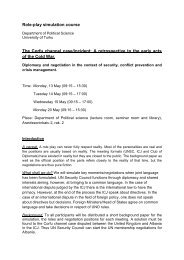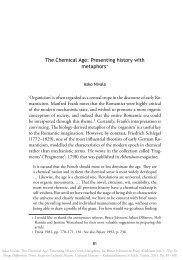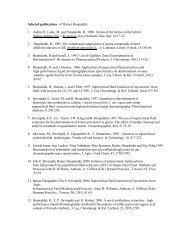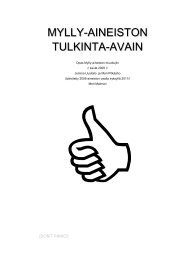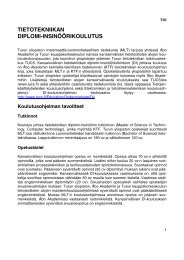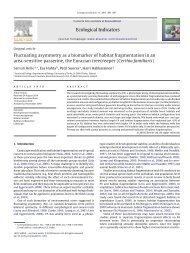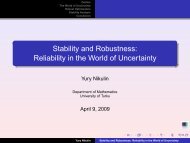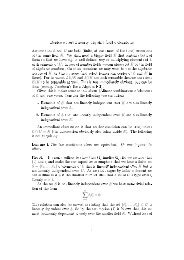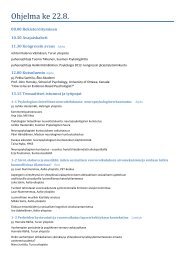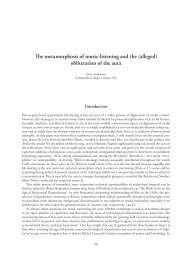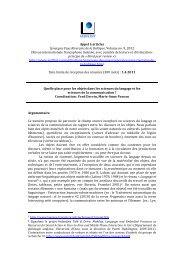MIRHAMI 2030 “Future Images of Food Consumption", Phase
MIRHAMI 2030 “Future Images of Food Consumption", Phase
MIRHAMI 2030 “Future Images of Food Consumption", Phase
Create successful ePaper yourself
Turn your PDF publications into a flip-book with our unique Google optimized e-Paper software.
SECTION II: GLOBAL REPORT SUMMARY & ANALYSIS<br />
Mirhami <strong>2030</strong><br />
The Basic Plan is expected to implement the following measures in the Comprehensive<br />
measures for promotion <strong>of</strong> Shokuiku: promotion <strong>of</strong> Shokuiku at home, in schools, in daycare<br />
facilities, and in the communities; development <strong>of</strong> a national Shokuiku movement; promotion<br />
<strong>of</strong> interaction between food producers and consumers; support for activities designed to<br />
preserve traditional food culture, promotion <strong>of</strong> research and studies on diet, including food<br />
safety and nutrition, and promotion <strong>of</strong> information <strong>of</strong>fering and <strong>of</strong> knowledge exchange<br />
activities.<br />
To promote Shokuiku, deep connection between concerned government <strong>of</strong>fices, such as the<br />
Cabinet Office.s <strong>Food</strong> Safety Commission (FSC), and the Ministry <strong>of</strong> Education, Culture,<br />
Sports, Science and Technology (MEXT), the Ministry <strong>of</strong> Health, Labour and Welfare<br />
(MHLW), and the Ministry <strong>of</strong> Agriculture, Forestry, and Fisheries (MAFF), is essential. It is<br />
worth noting that, under the leadership <strong>of</strong> the Cabinet Office (CAO), those government <strong>of</strong>fices<br />
will share a common understanding about Shokuiku in order to develop and implement<br />
necessary measures in a comprehensive and consistent manner. Local governments are also<br />
expected to have appropriate connection between related departments or institutions to work<br />
on Shokuiku progresses.<br />
From an international perspective, the comprehensive approach based on such a wideranging<br />
concept is considered to be unique to Japanese Shokuiku, whereas in the West, more limited<br />
approaches such as nutrition education programs aimed at reducing obesity and organized<br />
participation in agricultural education farms are practiced. For this reason, Japanese<br />
government transmits the concept <strong>of</strong> Shokuiku to foreign countries actively in accordance with<br />
the Basic Plan.<br />
2.4 CONSUMERISM: FOOD HABITS AND PATTERNS<br />
By culture<br />
Similarities between different cultures?<br />
Trends in changes <strong>of</strong> food habits<br />
<strong>Food</strong> habits (consumption habits, daily meal schedules, eating alone or together with the<br />
friends/family, who is cooking/buying*), changes, reasons for change<br />
§ for all these items we don’t have answers in our reports<br />
2.4.1 America: Canada & USA<br />
After decades <strong>of</strong> decline in the simple ritual <strong>of</strong> family dinners, there is evidence that many<br />
families are making the effort to gather at the dinner table. A random nationwide survey by the<br />
National Center on Addiction and Substance Abuse at Columbia University found a recent rise<br />
in the number <strong>of</strong> children ages 12 to 17 who said they ate dinner with their families at least five<br />
times a week, to 58 percent in 2005 from 47 percent in 1998 (Kitchen Gardner’s International).<br />
LOHAS Consumers<br />
Consumers <strong>of</strong> the LOHAS (Lifestyle <strong>of</strong> Health and Sustainability) market segment, or<br />
Lohasians, are concerned with health and fitness, the environment, personal development,<br />
sustainability, and social justice. Lohasians make up approximately 16% <strong>of</strong> the American adult<br />
population, or 35 million consumers. This group regularly purchases ecofriendly products and<br />
plays an active role in protecting the environment.<br />
© Finpro & Finland Futures Research Centre<br />
33




